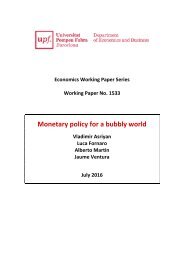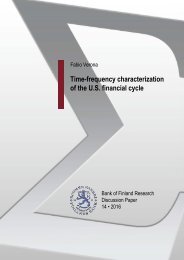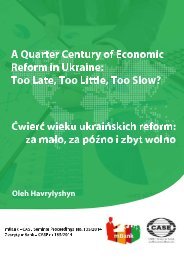Necessity as the mother of invention monetary policy after the crisis
n?u=RePEc:dnb:dnbwpp:525&r=mac
n?u=RePEc:dnb:dnbwpp:525&r=mac
You also want an ePaper? Increase the reach of your titles
YUMPU automatically turns print PDFs into web optimized ePapers that Google loves.
Table 12. The role <strong>of</strong> forward guidance <strong>after</strong> <strong>the</strong> <strong>crisis</strong><br />
Governors Academics Chi-sq.<br />
All AEs vs. all vs. AEs<br />
Forward guidance (NG=39, NA=156) 26.0*** 30.3***<br />
Remain potential instrument 59.0 50.0 75.6<br />
Remain, but in modified form 12.8 7.0 11.5<br />
Be discontinued 0.0 0.0 9.0<br />
Too early to judge 28.2 42.9 3.9<br />
Notes: Figures denotes percentage <strong>of</strong> respondents. *** denotes significance at <strong>the</strong> 1% level,<br />
calculated using Chi-square tests for <strong>the</strong> independence <strong>of</strong> <strong>the</strong> responses <strong>of</strong> governors and academics.<br />
NG/NA denotes number <strong>of</strong> responding governors/academics. Source: Authors’ calculations b<strong>as</strong>ed on<br />
survey conducted in 2016.<br />
While a consensus about <strong>the</strong> overall merits <strong>of</strong> forward guidance seems to be emerging,<br />
<strong>the</strong>re is far less agreement about <strong>the</strong> specific type <strong>of</strong> FG that should be pursued (see Table<br />
13). Our survey <strong>as</strong>ked governors and academics alike: “In <strong>the</strong> future, which type(s) <strong>of</strong><br />
forward guidance do you believe would be most effective for your central bank?” 25<br />
Table 13. Preferred types <strong>of</strong> forward guidance in <strong>the</strong> future<br />
Governors Academics Chi-sq.<br />
All AEs vs. all vs. AEs<br />
Forward guidance in <strong>the</strong> future (NG=52, NA=158)<br />
Calendar b<strong>as</strong>ed 13.5 25.0 10.8 0.3 2.8*<br />
Data b<strong>as</strong>ed 26.9 25.0 68.4 27.6*** 11.9***<br />
Purely qualitative 38.5 43.8 22.2 5.4** 3.7*<br />
None 11.5 12.5 4.4 3.4* 1,9<br />
O<strong>the</strong>r 15.4 25.0 3.8 8.4*** 12.1***<br />
Too early to judge 21.2 25.0 4.4 13.9*** 10.4***<br />
Notes: Figures denotes percentage <strong>of</strong> respondents. */**/*** denotes significance at <strong>the</strong> 10%/5%/1%<br />
level, calculated using using Chi-square tests for <strong>the</strong> independence <strong>of</strong> <strong>the</strong> responses <strong>of</strong> governors<br />
and academics. NG/NA denotes number <strong>of</strong> responding governors/academics. Source: Authors’<br />
calculations b<strong>as</strong>ed on survey conducted in 2016.<br />
Feroli et al. (2016) express a preference for data-b<strong>as</strong>ed FG, reserving time-dependent<br />
FG for unusual circumstances. This view is in line with <strong>the</strong> opinions <strong>of</strong> our academics,<br />
two-thirds <strong>of</strong> whom favor data-b<strong>as</strong>ed FG. But <strong>the</strong> central bank governors in our survey<br />
feel quite differently: Only about a quarter <strong>of</strong> <strong>the</strong>m favor data-b<strong>as</strong>ed FG. More favor purely<br />
qualitative FG. Repeating <strong>the</strong> exercise <strong>of</strong> Section 3, we once again find that governors<br />
who gained some experience with a certain type <strong>of</strong> FG also <strong>as</strong>sess it more positively (see<br />
Table 14).<br />
25<br />
Given that academics had not yet been introduced to <strong>the</strong> different types <strong>of</strong> forward guidance, we started this question along<br />
<strong>the</strong> same lines <strong>as</strong> <strong>the</strong> previous question for central bank governors.<br />
31








